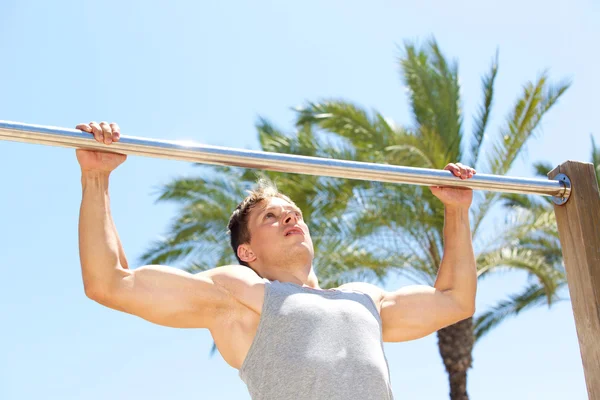Bodyweight pull exercises are a type of strength training that relies on your body weight to provide resistance during the exercise. Unlike traditional weight training, which often requires equipment like dumbbells or barbells, you can perform bodyweight exercises anywhere without the need for external weights. This makes them highly versatile and accessible, allowing you to perform effective workouts at home, in the park, or even while traveling.
Incorporating pull exercises into your workout routine is essential for achieving a balanced and comprehensive fitness regimen. Pull exercises primarily target the muscles of the upper body, including the back, shoulders, and biceps. These exercises help develop upper body strength, improve posture, and enhance overall functional fitness. By balancing pull exercises with push exercises (like push-ups or dips), you can ensure that you are working opposing muscle groups. This promotes muscular balance and reduces the risk of injury.
Benefits of Bodyweight Pull Exercises
Bodyweight exercises offer lots of benefits, as you’ll learn in this section.

Muscle Strength and Endurance
Bodyweight pull exercises are excellent for building muscle strength and endurance, particularly in the upper body. These exercises target the major muscle groups, such as the latissimus dorsi (lats), trapezius, rhomboids, and biceps. When you perform pull exercises like pull-ups, chin-ups, and inverted rows, you engage these muscles, leading to increased muscle hypertrophy (growth) and strength. Over time, as you consistently challenge your muscles with bodyweight pull exercises, you will notice significant improvements in your ability to lift and pull heavier loads.
Additionally, bodyweight pull exercises enhance muscle endurance, allowing your muscles to perform prolonged activities without fatigue. This endurance is crucial for athletic performance and everyday activities that require lifting, pulling, or carrying objects. Improved muscle endurance can lead to better performance in sports, recreational activities, and daily tasks, making you more efficient and resilient.
Improved Posture and Back Health
Poor posture is a common issue in today’s sedentary lifestyle, often leading to back pain and discomfort. Bodyweight pull exercises are particularly beneficial for improving posture and promoting back health. By strengthening the muscles of the upper back and shoulders, these exercises help counteract the effects of prolonged sitting and forward-slouching postures.
When you perform pull exercises, you activate the muscles responsible for retracting and stabilizing the shoulder blades (scapulae). This action helps to open up the chest and align the spine properly, reducing the strain on the lower back and neck. Improved posture enhances your physical appearance and reduces the risk of developing chronic back pain and other related issues.
Convenience and Accessibility
One of the most significant advantages of bodyweight pull exercises is their convenience and accessibility. Unlike exercises that require specialized equipment or a gym membership, bodyweight pull exercises can be performed virtually anywhere. Whether you’re at home, in a park, or traveling, you can easily incorporate these exercises into your routine.
This convenience eliminates many common barriers to regular exercise, such as time constraints, lack of access to a gym, or financial limitations. With just a pull-up bar or even a sturdy horizontal surface, you can perform a variety of effective bodyweight pull exercises to maintain and improve your fitness levels.
Versatility and Progression
Bodyweight pull exercises offer a high degree of versatility and can be adapted to suit different fitness levels and goals. For beginners, exercises like inverted rows or assisted pull-ups provide an excellent starting point to build foundational strength. As you progress, you can gradually increase the difficulty by incorporating more challenging variations, such as weighted pull-ups or one-arm chin-ups.
This scalability ensures that you can continuously challenge your muscles and avoid plateaus in your training. Additionally, bodyweight pull exercises can be combined with other bodyweight movements to create comprehensive and dynamic workout routines that target multiple muscle groups, improve cardiovascular fitness, and enhance overall functional strength.
Cost-Effective Fitness Solution
Another notable benefit of bodyweight pull exercises is their cost-effectiveness. Since these exercises require minimal or no equipment, you can achieve a high-quality workout without investing in expensive gym memberships or home gym equipment. A simple pull-up bar, which can be installed in a doorway or used outdoors, is often sufficient to perform a wide range of pull exercises.
This cost-effective approach to fitness makes bodyweight pull exercises an ideal solution for individuals looking to stay fit on a budget. It also allows for greater flexibility and freedom in your workout routine, enabling you to train effectively regardless of your financial situation.
Essential Bodyweight Pull Exercises
When starting bodyweight pull exercises, these are the essential exercises to include in your routine.
Pull-ups
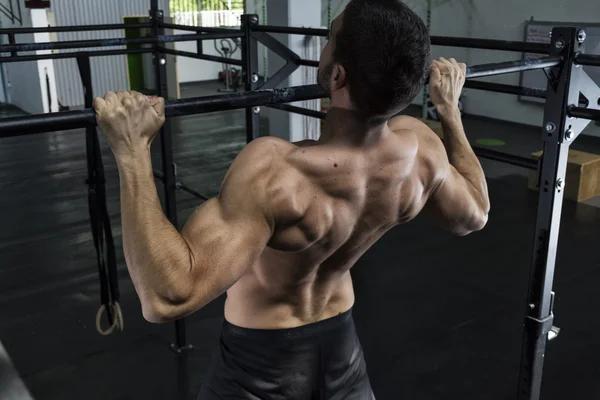
How to Perform a Proper Pull-up
Pull-ups are one of the most effective bodyweight pull exercises for building upper body strength. To perform a proper pull-up:
- Grip the Bar: Start by gripping the pull-up bar with your palms facing away from you (overhand grip), hands shoulder-width apart.
- Engage Your Core: Tighten your core muscles to stabilize your body and prevent swinging.
- Hang with Straight Arms: Allow your body to hang with your arms fully extended and your shoulders relaxed.
- Initiate the Pull: Begin the pull by engaging your lats and pulling your shoulder blades down and back.
- Pull Up: Pull your body upward until your chin is above the bar, keeping your elbows close to your body.
- Lower Down: Slowly lower your body back to the starting position with controlled movement.
Variations
- Wide Grip Pull-ups: Position your hands wider than shoulder-width to target the outer parts of the back muscles.
- Close Grip Pull-ups: Place your hands closer together to focus more on the biceps and inner back muscles.
- Neutral Grip Pull-ups: Use parallel bars or handles with palms facing each other, which can be easier on the wrists and shoulders.
Common Mistakes and How to Avoid Them
- Kipping: Avoid using momentum to swing your body upward. Focus on controlled movements and proper form.
- Partial Range of Motion: Ensure you lower your body fully and extend your arms completely before initiating the next pull.
- Flared Elbows: Keep your elbows close to your body to engage the correct muscles and prevent shoulder strain.
Chin-ups
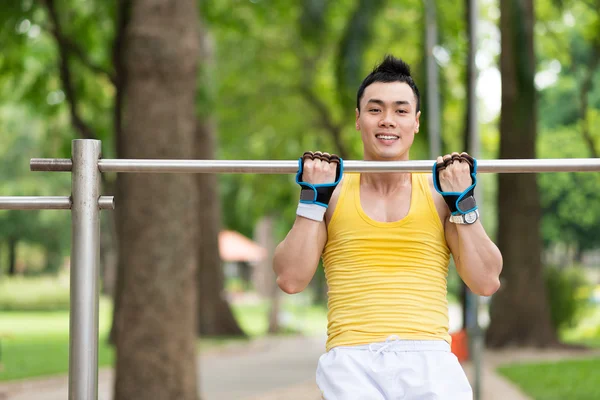
Chin-ups differ from pull-ups primarily in the grip used. For chin-ups, your palms face towards you (underhand grip), which places more emphasis on the biceps and less on the lats compared to pull-ups.
How to Perform Chin-ups Correctly
- Grip the Bar: Grab the bar with an underhand grip, hands shoulder-width apart.
- Engage Your Core: Tighten your core muscles to keep your body stable.
- Hang with Straight Arms: Start from a dead hang with arms fully extended.
- Initiate the Pull: Engage your biceps and pull your shoulder blades down and back.
- Pull Up: Lift your body until your chin is above the bar, keeping your elbows close to your torso.
- Lower Down: Slowly lower your body back to the starting position.
Variations and Progression Tips
- Assisted Chin-ups: Use resistance bands or a partner to help support your weight as you build strength.
- Negative Chin-ups: Focus on the lowering phase by starting at the top position and slowly lowering yourself down.
- Weighted Chin-ups: Add weight using a dip belt or weighted vest as you become stronger.
Inverted Rows
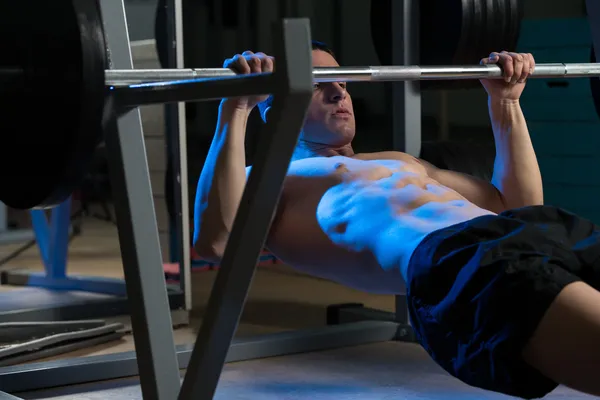
Inverted rows are an excellent bodyweight pull exercise for targeting the back muscles while minimizing strain on the shoulders. This exercise can be performed using a barbell in a rack, suspension trainer, or even a sturdy table.
How to Perform Inverted Rows Using Different Equipment
- Barbell Inverted Rows:
- Set a barbell at waist height in a squat rack.
- Lie underneath the bar and grip it with an overhand grip, hands shoulder-width apart.
- Keep your body straight, heels on the ground, and pull your chest to the bar.
- TRX Inverted Rows:
- Adjust the TRX straps to your desired length.
- Hold the handles with an overhand grip and lean back, keeping your body straight.
- Pull your chest towards the handles, engaging your back muscles.
Modifications for Beginners and Advanced Variations
- Beginners: Keep your feet on the ground and bend your knees to reduce the intensity.
- Advanced: Elevate your feet on a bench or stability ball to increase the difficulty.
Bodyweight Rows
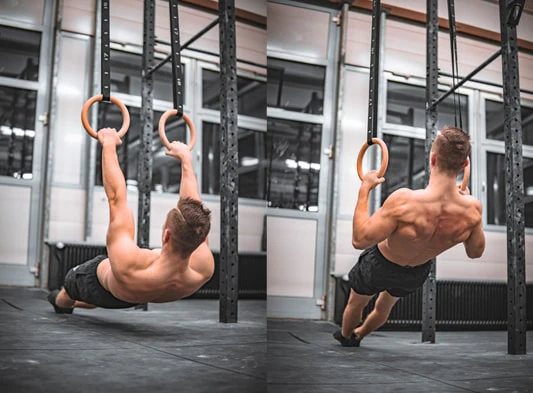
You can do bodyweight rows using a sturdy surface or rings.
How to Do Bodyweight Rows Using a Sturdy Surface
- Find a sturdy horizontal surface (e.g., a low bar or edge of a table).
- Lie underneath the surface and grip it with an overhand grip.
- Keep your body straight and pull your chest to the surface, then lower back down.
How to Do Bodyweight Rows Using Rings
- Use gymnastic rings set at an appropriate height.
- Hold the rings with an overhand grip and lean back, keeping your body straight.
- Pull your chest to the rings, then lower back down.
Progression Techniques to Increase Difficulty
- Adjust Angle: Increase the angle of your body relative to the ground to make the exercise harder.
- Single-Arm Rows: Perform rows using one arm to challenge your stability and strength.
Towel Rows
Towel rows are particularly beneficial for improving grip strength due to the instability and thickness of the towel. This bodyweight pull exercise challenges your forearms and hands, enhancing overall grip endurance.
Performing Rows Using a Towel and Door
- Setup: Place a sturdy towel over the top of a closed door, ensuring it is secure.
- Hold both ends of the towel and lean back with your body straight.
- Pull your chest towards the door, engaging your back muscles.
Step-by-Step Guide and Common Pitfalls
- Grip the Towel Securely: Ensure a firm grip on the towel to maintain control throughout the exercise.
- Keep Your Body Straight: Avoid sagging hips or bending at the waist to ensure proper form.
- Engage Your Back: Focus on pulling with your back muscles rather than relying on your arms alone.
Progressions and Modifications
You can modify any of these pull exercises by increasing or decreasing difficulty.
Increasing Difficulty
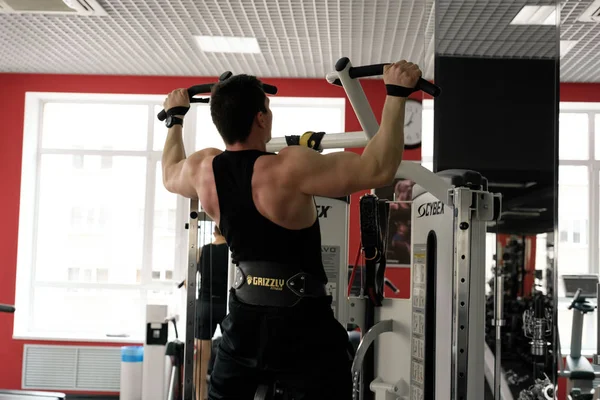
- Adding Weight: One of the most straightforward ways to increase the difficulty of bodyweight pull exercises is to add weight. This can be done using a weight vest, dip belt with weights, or even a backpack filled with heavy items. Adding weight challenges your muscles further and promotes greater strength gains.
- Increasing Repetitions or Sets: Another method to increase difficulty is by adding more repetitions or sets to your routine. Gradually increasing the number of pull-ups, chin-ups, or rows you perform in each workout session helps build endurance and strength over time.
- Changing Grip Width: Adjusting the width of your grip can also make exercises more challenging. For example, wide-grip pull-ups require more strength and engage different muscle fibers compared to standard pull-ups.
- Advanced Variations: Incorporating advanced variations of exercises, such as one-arm pull-ups or typewriter pull-ups, significantly increases the difficulty. These variations require greater strength, balance, and coordination.
- Tempo Training: Slowing down the tempo of your movements, especially during the eccentric (lowering) phase, increases the time your muscles are under tension, promoting muscle growth and strength.
Decreasing Difficulty
- Assistance Bands: Using assistance bands is an excellent way to decrease the difficulty of pull exercises. Loop the band over the pull-up bar and place your feet or knees in the band to reduce the amount of body weight you need to lift. This is particularly useful for beginners who are building their strength.
- Performing Negative Repetitions: Focus on the eccentric phase by starting at the top position of the exercise and slowly lowering yourself down. Negative repetitions help build strength and control, making it easier to eventually perform full repetitions.
- Modified Versions: Opt for modified versions of exercises, such as inverted rows or assisted chin-ups, which are easier but still effective at building strength. These modifications allow you to progress at your own pace without compromising form.
- Using a Chair or Step: Placing a chair or step under your feet during pull-ups or chin-ups can provide additional support, reducing the load on your upper body. This is a helpful modification for those who are still developing their upper body strength.
Using Assistance Bands or Chairs for Beginners
Assistance Bands
- Selecting the Right Band: Choose an assistance band with the appropriate level of resistance based on your current strength. Bands come in different thicknesses, with thicker bands providing more assistance.
- Setting Up: Loop the band securely over the pull-up bar and place one or both feet in the band. Ensure the band is stable before beginning the exercise.
- Performing the Exercise: Perform your pull-ups or chin-ups as usual, allowing the band to assist you by reducing the amount of body weight you need to lift. Gradually decrease the thickness of the band as you gain strength.
Chairs or Steps
- Positioning: Place a sturdy chair or step underneath the pull-up bar. Stand on the chair or step so that you start from a higher position.
- Using Assistance: Use the chair or step to help push yourself up if needed. Focus on using your upper body muscles to pull as much as possible, using the support only when necessary.
- Progression: Gradually rely less on the chair or step as you build strength, aiming to perform the exercise without assistance over time.
Combining Pull Exercises with Push and Leg Exercises
A well-rounded workout routine includes a balance of pull, push, and leg exercises to ensure that all major muscle groups are engaged and strengthened. Here’s how to combine bodyweight pull exercises with push and leg exercises for a comprehensive workout:
Push Exercises
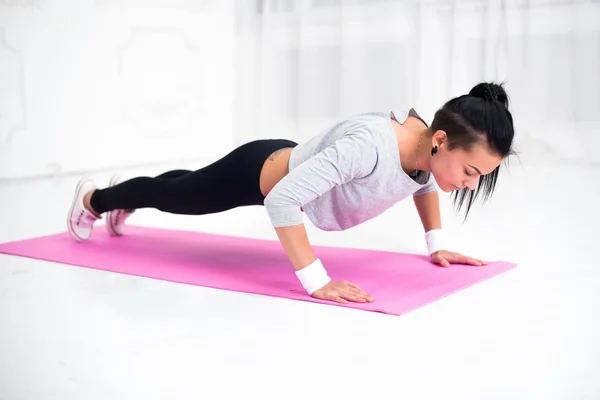
- Push-ups: Standard, wide grip, close grip, and variations like diamond push-ups or decline push-ups.
- Dips: Using parallel bars, a bench, or rings to target the chest, shoulders, and triceps.
- Handstand Push-ups: For advanced practitioners, these target the shoulders and upper back intensely.
Leg Exercises
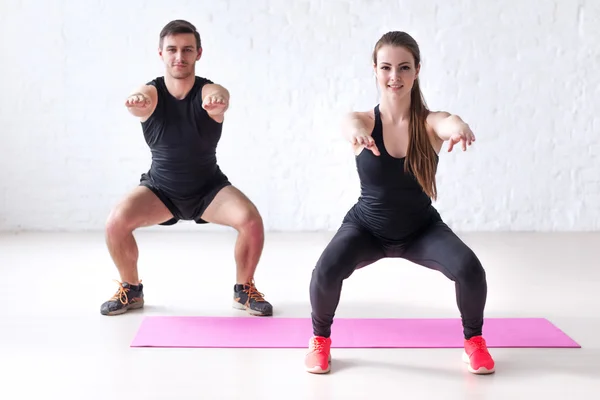
- Squats: Bodyweight squats, jump squats, and pistol squats (one-legged squats) for overall leg strength.
- Lunges: Forward, reverse, and walking lunges to engage the quads, hamstrings, and glutes.
- Glute Bridges: For targeting the glutes and lower back, with variations like single-leg glute bridges.
Core Exercises
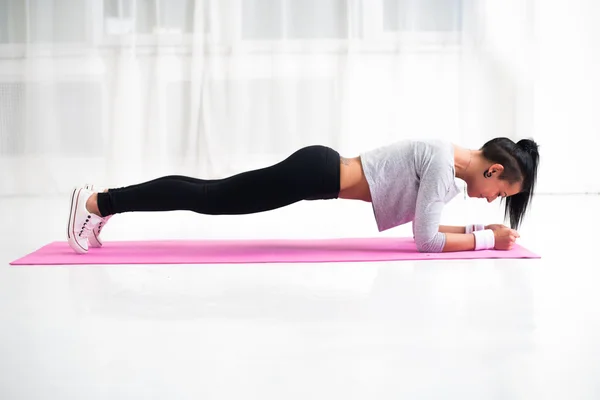
- Planks: Standard planks, side planks, and variations to strengthen the core.
- Leg Raises: Hanging or lying leg raises to target the lower abs.
- Mountain Climbers: A dynamic exercise that also elevates the heart rate.
Sample Workout Routines Incorporating Bodyweight Pull Exercises
You can start bodyweight pull exercises at home using one of the best home fitness apps, like Aaptiv or Peloton, or you can do them at the gym with help from a trainer. We’ve rounded up some routines for beginners, intermediate trainers, and seasoned gym-goers.
Beginner Routine
- Warm-Up: 5-10 minutes of light cardio (e.g., jogging in place, jumping jacks).
- Circuit (3 rounds):
- 10 Pull-ups (use assistance bands if needed)
- 15 Push-ups
- 20 Bodyweight Squats
- 15 Inverted Rows
- 20 Lunges (10 per leg)
- 30-second Plank
- Cool-Down: 5-10 minutes of stretching, focusing on the muscles worked.
Intermediate Routine
- Warm-Up: 5-10 minutes of dynamic stretches and mobility exercises.
- Circuit (4 rounds):
- 12 Pull-ups (varied grips: wide, neutral, close)
- 20 Push-ups (varied styles: standard, diamond)
- 25 Jump Squats
- 20 Inverted Rows (increase angle for difficulty)
- 25 Walking Lunges (each leg)
- 45-second Plank
- Cool-Down: 5-10 minutes of stretching, focusing on the muscles worked.
Advanced Routine
- Warm-Up: 10 minutes of dynamic stretching and foam rolling.
- Superset (5 rounds):
- 15 Pull-ups (add weight if possible)
- 20 Dips (parallel bars or rings)
- 20 Pistol Squats (10 per leg)
- 20 Chin-ups (add weight if possible)
- 25 Handstand Push-ups (against a wall if needed)
- 60-second Side Plank (each side)
- Cool-Down: 10 minutes of stretching, focusing on the muscles worked.
Conclusion
Incorporating bodyweight pull exercises into your fitness routine can significantly enhance your strength, flexibility, and overall physical health. By understanding the benefits, mastering proper techniques, progressing safely, and creating a balanced workout routine, you can achieve your fitness goals effectively. Remember to set realistic goals, stay motivated, avoid common mistakes, and leverage resources for support. Prioritizing rest and recovery will ensure sustainable progress and prevent injuries. Embrace these exercises, stay consistent, and enjoy the journey towards a stronger, healthier you.

